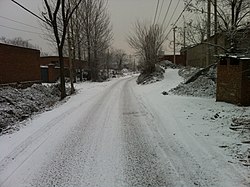Kaiping, Tangshan
District in Hebei, People's Republic of China From Wikipedia, the free encyclopedia
District in Hebei, People's Republic of China From Wikipedia, the free encyclopedia
Kaiping District (simplified Chinese: 开平区; traditional Chinese: 開平區; pinyin: Kāipíng Qū) is a district of Tangshan, Hebei, China. The district spans an area of 236 square kilometres (91 sq mi), as has a population of about 240,000 as of 2012.[1]
Kaiping District
开平区 | |
|---|---|
 A winter scene in Kaiping District | |
| Coordinates: 39°40′16″N 118°15′43″E | |
| Country | People's Republic of China |
| Province | Hebei |
| Prefecture-level city | Tangshan |
| Area | |
| • Total | 236 km2 (91 sq mi) |
| Population (2012) | |
| • Total | 240,000 |
| • Density | 1,000/km2 (2,600/sq mi) |
| Time zone | UTC+8 (China Standard) |
From the Qin dynasty to the Han dynasty, present-day Kaiping District was part of Youbeiping Commandery.[2] During the Tang dynasty, the area was reorganized as Shicheng County (Chinese: 石城县; pinyin: Shíchéng Xiàn).[2] Shicheng County was abolished during the Liao dynasty.[2] The area was reorganized as Yifeng County (Chinese: 义丰县; pinyin: Yìfēng Xiàn) during the Yuan dynasty.[2] During the Ming dynasty, the area fell under the jurisdiction of Zhending Fu.[2] In the Qing dynasty, the area was split between Luanzhou County (Chinese: 滦州县; pinyin: Luánzhōu Xiàn) and Fengrun County (Chinese: 丰润县; pinyin: Fēngrùn Xiàn).[2]
In 1949, upon the establishment of the People's Republic of China, the area was reorganized as Tangshan Fifth District (Chinese: 唐山市第五区; pinyin: Tángshān Shì Dì Wǔ Qū).[2] In 1956, it was placed under the jurisdiction of Jiao District (Chinese: 郊区; pinyin: Jiāo Qū; lit. 'Suburb').[2] The area was briefly organized as Kaiping District from 1961 to 1965, before being replaced by Jiao District.[2] In 1982, Kaiping District was re-established.[2]
Kaiping District is located near the southern foothills of the Yan Mountains.[1] Elevation in the district ranges from 11 metres (36 ft) to 296.6 metres (973 ft) above sea level, with the northern portion of the district generally having a higher elevation.[1]
Major rivers in Kaiping District include Shiliu River (Chinese: 石榴河; pinyin: Shíliú Hé; lit. 'Pomegranate River') and Dou River.[1]
Kaiping District administers five subdistricts and six towns.[3]
The five subdistricts in Kaiping District are Majiagou Subdistrict, Kaiping Subdistrict, Shuiwuzhuang Subdistrict, Doudian Subdistrict, and Jinggezhuang Subdistrict.[3]
The six towns in Kaiping District are Kaiping, Liyuan, Yuehe, Shuangqiao, Zhengzhuangzi, and Wali.[3]
Kaiping District has an estimated population of about 240,000 as of 2010.[1] In the 2010 Chinese census, Kaiping District had a recorded population of 262,571, down slightly from 266,378 in the 2000 Chinese Census.[2] The district had an estimated population of 259,000 in 1996.[2]
Kaiping District's main industries include coal, building materials, chemicals, and ceramics.[1]
Major mineral deposits in Kaiping District include coal, bauxite, sand, and gravel.[1]
The Beijing–Harbin railway and National Highway 205 both run through Kaiping District.[1]
Seamless Wikipedia browsing. On steroids.
Every time you click a link to Wikipedia, Wiktionary or Wikiquote in your browser's search results, it will show the modern Wikiwand interface.
Wikiwand extension is a five stars, simple, with minimum permission required to keep your browsing private, safe and transparent.